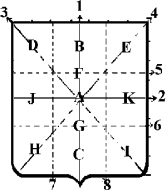English glossary
This glossary, the reader will suspect it, is far from being exhaustive.
To understand and draw a blazon, it is necessary to start by knowing the form, space of it and reconstituting it using the names indicated in the lexicon which follows. When, in a blazoning, a position is not indicated, see the one which is known as ordinary.
The shield or Escutcheon.
The armorial bearings appeared at the beginning of the XI eme century. There was not really before.
Some say escutcheon for coat of arms wrongly. The word escutcheon only gets busy to indicate a small shield placed on large one
The form of the shield varied considerably in time and space. The French coat of arms was originally the exact representation of the shield, if not the shield itself, which one imagined to paint of a color, then of two, then several different colors and on which each one to be distinguished ends up representing a particular figure. Then it became about triangular. A shield indicated as being a shield in banner is square.
The heralds charged to blazon, i.e. to explain the armorial bearings, brought back all the shields to identical proportions in their assigning the form of a quadrilateral made up of seven parts of width on eight height whose lower angles swell of a quadrant and whose ray is of a half-part; two of the same quadrants radius in the medium of the horizontal line of bottom join apart from this line and form the point. It is the blazon samnite, the French modern blazon. All are useful of the same distribution inside this support of decorations.
|

|
The shield is divided into the following parts :
D, B, E united are the chief of the sheild.
B is the (middle) chief point.
D is the dexter (right hand) point of the chief.
E is the sinister (left hand) point pf the chief.
F is the collar, or honnour point of the shield.
A is the center point of the shield, heart or fess point.
G is the nombril or navel point of the shield.
C is the (middle) base point of the shield.
H is the dexter base point.
I is the sinister base point.
J is the dexter flank.
K is the sinister flank.
The lines :
1 : define the per pale.
2 : define the per fess.
1 et 2 : define the quartered.
3 : define the per bend.
4 : define the per bend sinister.
3 and 4 : define the quartered by saltire.
1, 2, 3 et 4 : define the gironny.
5 and 6 : define the fess inside the shield and the tierced in fess.
7 and 8 : define the pal inside the shield and the tierced in pal.
There are the principals parts of the shield.
|
Originally the blazon represents the warrior's shield. His drawing is personal and it helps him to be recognize during tournamants or battle. The blazon is specially desing from the knight. Thant means thet when we talk about the dexter (righ in latin) it's the warrior's right but the spectator's left, while the sinister will be at his left but at our right. The words dexter and sinister will be used to avoid to confuse people.
How to read a blazon
A blazon can be read generally from dexter to sinister and from chief to point, like a book's page. First we named the field, the the honorables or main piece and then those charge it or go with. This rule is not absolute but make the understanding easier. Sometimes priorities or short cuts change the rule but a quarterly will always begin by the dexter chief side, generally called "1st" or by the the upper part in a quarterly in saltire.
A couped will start by the higest part, a party by the dexter side, a chequy will also named first the upper dexter point, because naming it upside down may changes the presentation. The same goes for all repetitive representation, squares, triangles, vair, etc. even if the first is half visible or none.
If another position is not indicated, a piece alone will always be places in the middle of the blazon, or in the middle of the other piece who is charging.
The blazon is covered by a colour, a metal or by a fur, that's what wee called field by analogy with the battlefield. We only saying that when a piece is pierced ot let see the field or to avoid repetition when a piece in the blazon is of the same émanel.
When we begin blazonning, we say " gules, gold, silver, etc. " that means the field (not the bottom) is gules or gold, etc. The blazon will be charged by honorables pieces or not and/or furnitures. If one of these items received another one on his area, we say that it's charged of ...